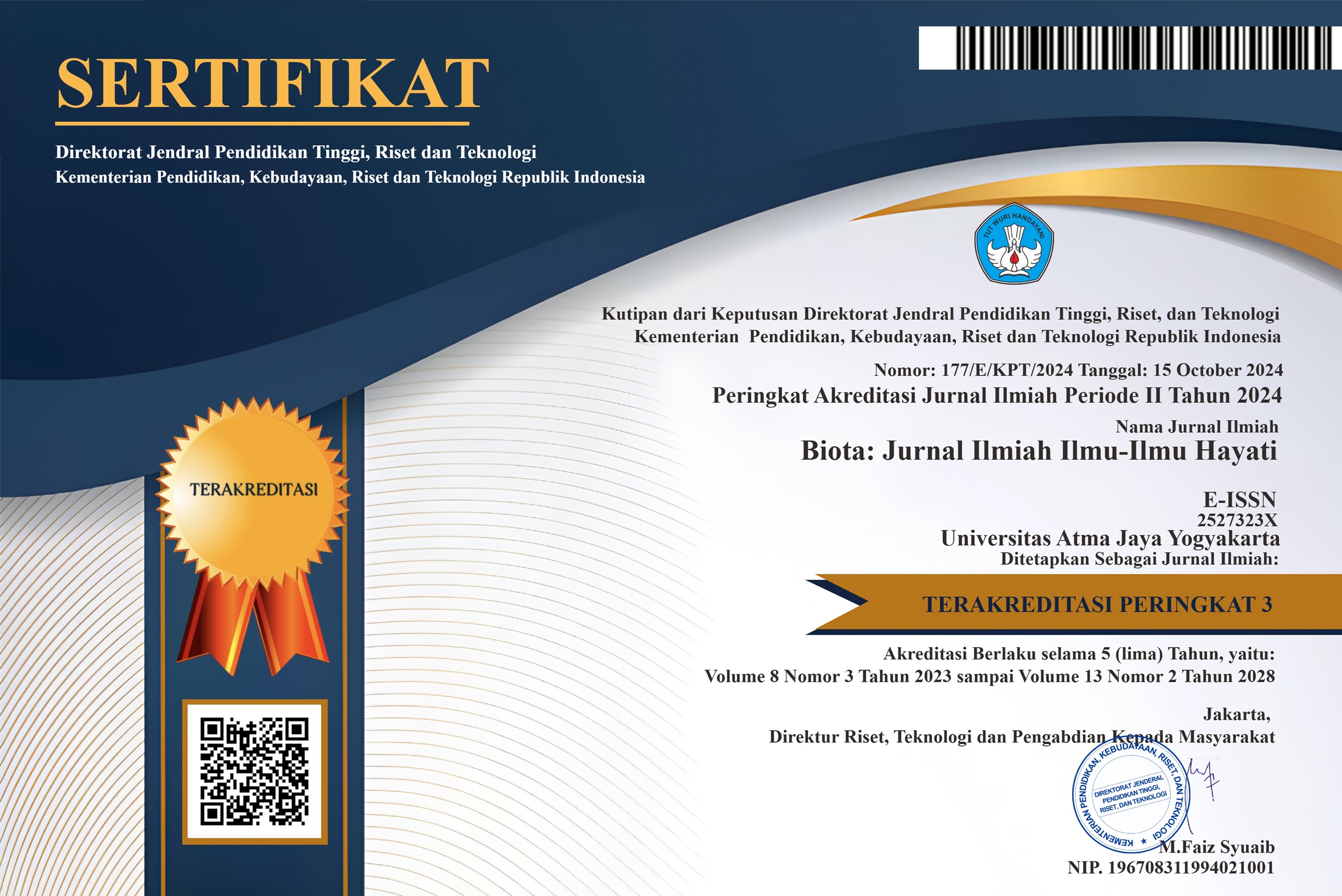Analisis Keanekaragaman Isolat Bacillus thuringiensis yang Patogenik terhadap Serangga Hama Kubis (Crocidolomia binotalis) dengan Pendekatan Sistematika Numerik
DOI:
https://doi.org/10.24002/biota.v15i3.2605Keywords:
Diversity, Bacillus thuringiensis, isolates, pathogenic, Crocidolomia binotalis, numerical systematicAbstract
Diversity of B. thuringiensis (Bt.) isolates pathogenic to C. binotalis was determined by using Numerical Systematic Method. Ten isolates were taken to represent 34 pathogenic isolates along with two reference strains namely B. thuringiensis serovar kurstaki and B. thuringiensis serovar israelensis. The test isolates were examined for 89 phenotypic characters by using convensional method for colonial and cell morphology (37 characters) as well as physiological characteristics (3 characters) but biochemical characterization (49 characters) was conducted by using commercial API-50 CHB procedures. All phenotypic characters existed in one of two mutually exclusive states and were either scored plus (1) of minus (0). The binary data were prepared in Programmer’s File Editor (PFE) software. The data then were analysed by using the Multi Variate statistical Package (MVSP) Plus-Version 3.1 using the Simple Matching Coefficient (SSM). Clustering was achieved using the UPGMA algorithm. The results were presented as dendrograms. It was obtained that the test isolates were clearly assigned to two distinct multimembered clusters defined by 79.6 similarity level (S-level) in the SSM, UPGMA analysis. The two distinct clusters represented by each of two widely known different group of Bt. strains, namely serovar israelensis and serovar kurstaki. The first cluster contained reference strain of B. thuringiensis serovar israelensis, and two of the isolates (Slk2.3, and YPPA1) and the second cluster contained another reference strain of B. thuringiensis serovar kurstaki, and 8 of the isolates. Therefore, it strongly suggested that the application of numerical-fenetic analysis could provide a tool to unravel the strain diversity belong to B. thuringiensis.Downloads
Published
15-10-2019
How to Cite
Salaki, C. L., Situmorang, J., Sembiring, L., & Handayani, N. (2019). Analisis Keanekaragaman Isolat Bacillus thuringiensis yang Patogenik terhadap Serangga Hama Kubis (Crocidolomia binotalis) dengan Pendekatan Sistematika Numerik. Biota : Jurnal Ilmiah Ilmu-Ilmu Hayati, 15(3), 469–476. https://doi.org/10.24002/biota.v15i3.2605
Issue
Section
Articles
License
Authors who publish with Biota : Jurnal Ilmiah Ilmu-Ilmu Hayati agree to the following terms:
- Authors retain copyright and grant the Biota : Jurnal Ilmiah Ilmu-Ilmu Hayati right of first publication. Licensed under a Creative Commons Attribution-NonCommercial 4.0 International License that allows others to share the work with an acknowledgment of the work's authorship and initial publication in this journal.
- Authors are able to enter into separate, additional contractual arrangements for the non-exclusive distribution of the journal's published version of the work (e.g., post it to an institutional repository or publish it in a book), with an acknowledgment of its initial publication in Biota : Jurnal Ilmiah Ilmu-Ilmu Hayati, and as long as Author is not used for commercial purposes.












